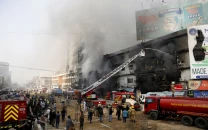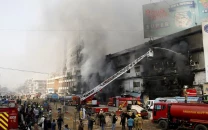Sindh alarmed by oil, gas shortage
Sindh is still largest contributor of oil and gas in Pakistan

Pakistan is facing an oil and natural gas shortage due to a considerable decrease in local production this year. The official data revealed that the commercial supply of oil decreased by 19.8 per cent in the financial year 2018-19 compared to the past years.
The Hydrocarbon Development Institute of Pakistan, under the Ministry of Energy has published the Pakistan Energy Yearbook 2019. It states that the country has seen a 6.7 per cent increase in total energy consumption during the last six years. An increase in consumption of over 130 per cent was witnessed in the government sector, while the increase recorded for the domestic sector was 4.8 per cent during the same period.
The report has noted that Sindh is still the largest contributor of oil and gas in the country. According to the Sindh energy department, the province contributed 60 per cent of the total oil production in the country in 2009.
Read more: Consumer court imposes fine on gas utility
The Sindh energy department states that a few districts of the province are rich in the production of gas. These include Khairpur Mirs, Kashmore, Ghotki, Dadu, Hyderabad, Sanghar, Sukkur, and Badin.
The report said that industries have the highest consumption of energy in the country at 37.1 per cent, while transport is second with 31 per cent.
In continuation of the downward trend, the commercial supply of Liquified Petroleum Gas (LPG) declined by 9.5 per cent in the financial year 2018-19 while its import grew by 18.9 per cent. Likewise, natural gas production declined by 1.5 per cent. However, the drilling of new wells in search of fresh reserves and an increase in the domestic production of coal has led to hope for the future.
Natural gas is still a major source of commercial energy supply in the country. It constitutes 35 per cent of the total commercial energy supply. Whereas, oil meets 25.7 per cent of the total energy needs.
According to the 2018-19 statistics, the country has 21.4 trillion cubic feet recoverable reserves of natural gas. However, its production was 3,936 MCF per day. According to the Sindh energy department data, the cumulative production of gas was 21,403 BCF, while the balance recoverable reserves stood at 12,746 BCF.
According to the department, the balance oil reserves till June 2019 were 361.76 million barrels. Districts Badin, Hyderabad, Tando Muhammad Khan and Sanghar have sufficient reserves of oil.
The Sindh government and civil society have been expressing serious concern over the rapid depletion of oil and gas reserves.
The common grievance is that the 18th Amendment introduced landmark provisions related to the oil and gas sectors of the provinces but these were not implemented. The Sindh Energy Department wrote to the Sindh Assembly that Article 172 (3) should be implemented in letter and spirit.
The Article envisages the vesting of oil and gas equally between the federal government and the provinces. However, oil and gas exploration is being controlled solely by the federal government, which is in contradiction of the Constitution.
Sindh Energy Minister Imtiaz Shaikh also voiced similar concerns, saying the Sindh government has no role in regulating oil and gas exploration and development. “The provinces should have representation in the oil and gas-related bodies of the federal government including the Oil and Gas Regulatory Authority (OGRA)”, he told The Express Tribune.
Published in The Express Tribune, February 2nd, 2021.











1733130350-0/Untitled-design-(76)1733130350-0-208x130.webp)






COMMENTS
Comments are moderated and generally will be posted if they are on-topic and not abusive.
For more information, please see our Comments FAQ